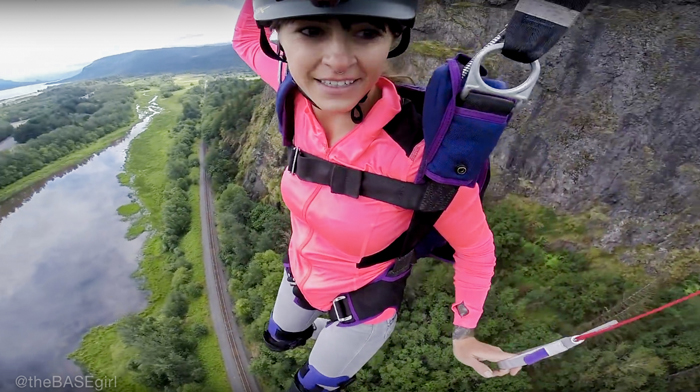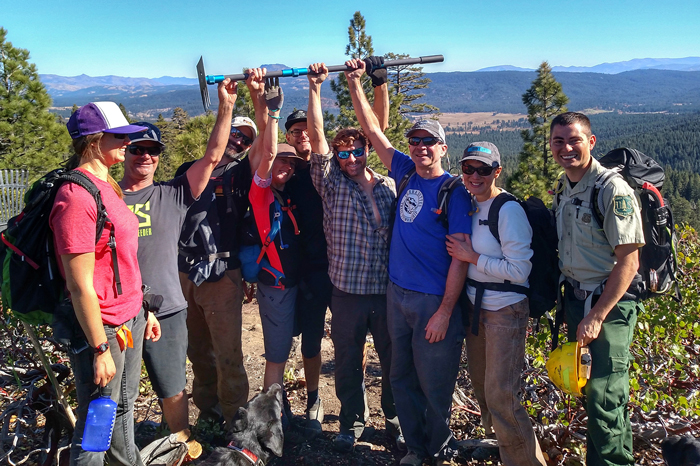- California Enduro Series Announces 2024 Schedule - 11/19/2023
- ASHLAND MOUNTAIN CHALLENGE 2023 – CES RACE REPORT - 10/04/2023
- China Peak Enduro 2023 – CES Race Report - 09/04/2023
Calculated risks
By Clair Marie

Exciting canopy flight after a short BASE jump in Oregon (Clair Marie Backwards POV).
Despite what most people believe, BASE jumpers don’t have a death wish. Instead we have a powerful desire to push ourselves to our limits and beyond. We challenge what we’re told are the limits and move past our fear in an educated and calculated way.
Most people think of BASE jumping as a crazy, adrenaline packed sport that attracts misfits and people with a screw loose. Why would anyone want to fall off a cliff? Well … I am one of those people. In addition to climbing and mountain biking I also happen to love BASE jumping, and in particular low exit BASE jumping, which generally refers to jumps of less than 1,000 feet. I don’t think of myself as crazy. Instead I am someone who likes to practice safety and self-reliance.
For those of you who don’t know, BASE is an acronym that stands for Building, Antenna, Span and Earth. The act of BASE jumping is to jump from one of these four main objects with a parachute on your back. Unlike skydiving out of an airplane which has both a main and a reserve parachute, a BASE jumping system only has one parachute, there is no reserve chute. BASE jumpers have one chance for success, which makes safety and preparation crucial!
There are many different disciplines that fall under the sport of BASE jumping: There’s Wingsuit BASE jumping from high cliffs and buildings that allow you to soar almost like a bird; track suit jumping that propels you forward using your body and a special suit to give you maximized distance while allowing your arms and legs to move freely; and then there is just BASE jumping — jumping from an object, no specialized clothing, and opening a parachute to land safely on the ground.
How to mitigate risk
BASE jumpers spend a lot of time identifying risk and figuring out the best way to mitigate that risk. Our sport has inherent danger associated with it. We have millions of years worth of DNA pumping through our veins telling us that if we jump, we’re going to die. That knowledge, that feeling that’s ingrained within us creates fear. Fear is totally normal and healthy to experience, but our goal is to push past that fear in the safest way possible. I have three pillars I go by:
— Know your ability level. Know what you are capable of and what you are not yet able to do.
— Operate well below your ability level. Sometimes things don’t go as planned and if you are giving 100%, you won’t have room to correct an error or deal with a situation.
— Be aware of the company you keep. In BASE jumping there is a really strong group mentality that factors into safety. It is almost like borrowed confidence. You are hanging out in a group and one person might be really experienced and ready to accept the risk associated with a specific jump, but another jumper might not. But because of the group mentality it is not uncommon to see new or inexperienced jumpers making bad decisions because other more experienced jumpers decided for themselves that they were comfortable with it.

Working on body rotation during a low exit jump (Alex Edge).
The risks of low exit BASE
A standard free fall time during BASE jump in the US will range from 1-10 seconds depending on the height of the object you leap from. The taller the object, the longer free fall you will get. Longer free fall and taller jumps aren’t always safer, just as lower jumps aren’t necessarily more dangerous. Each individual object has its own very unique traits that you need to pay attention to, and every jump has to be approached differently to ensure the best possible outcome.
Generally speaking though, safety comes from separation and separation is a result of time spent in the air. Lower jumps equal less time in the air, which equals less separation. The biggest risk factor associated with jumping lower objects is the potential for an object strike. If for some reason the parachute does not open perfectly your body is closer to the object, the time a jumper has to correct the problem is very short and the potential for an object strike is increased. Object strikes are incredibly dangerous and account for a high percentage of BASE jumping related injuries and fatalities.
When your body and parachute hit an object not only does the jumper suffer from the initial impact but there is the possibility of getting hung up on a snag point and dangling hundreds of feet in the air by something that could give away at any given time. This leaves the jumper suspended in the air waiting for rescue. If the jumper doesn’t get hung up, they will likely strike the object multiple times on the way down before hitting the ground with incredible force.
Another risk factor to consider when making low jumps is the reduced time under the parachute and the fact that the jumper is opening his/her parachute much closer to the ground. When making short jumps even milliseconds count. The jumper’s timing has to be perfect when opening his/her parachute, and fatalities resulting in a low pull or mistimed pull are not uncommon. Ideally a jumper would open high enough to have the ability to fix any potential issues and still have time to safely make his/her way to the landing area. Generally, the more time a jumper has under the parachute the better chance he/she has of landing safely. When jumping low objects the time spent under the canopy is minimized giving the jumper very little option to correct an issue or find an alternate landing area.
Although the stakes can be higher when participating in low jumps, I enjoy it because it requires proper preparation and being at the top of my game. Low exit BASE forces me to react quickly and accurately under pressure. Most importantly it has taught me to not be afraid to walk away if things aren’t right. For me, these are skills that help me in every aspect of my life.

Exit Bliss and freefall freedom in Moab, Utah (Alex Edge).












